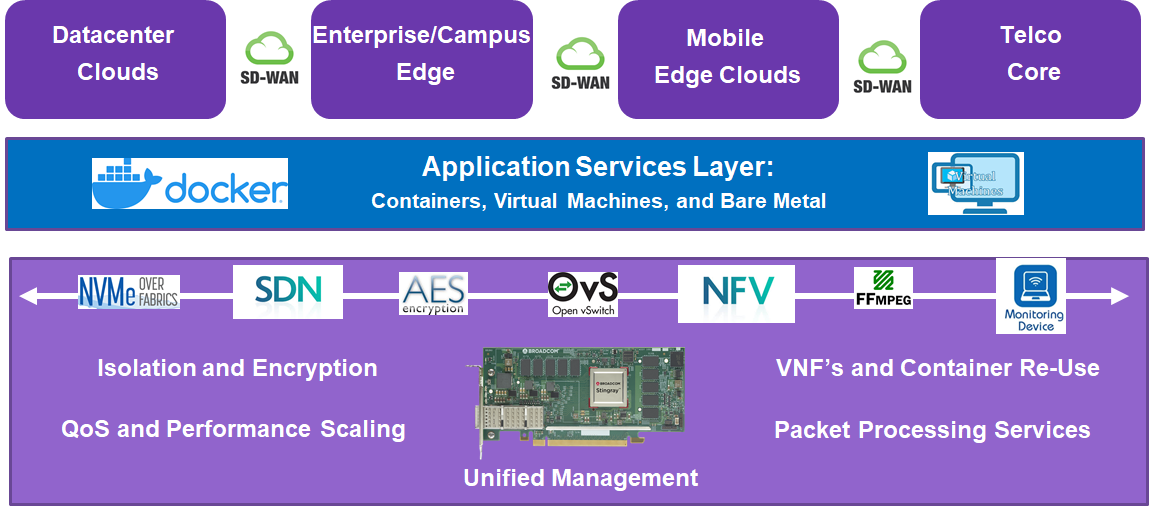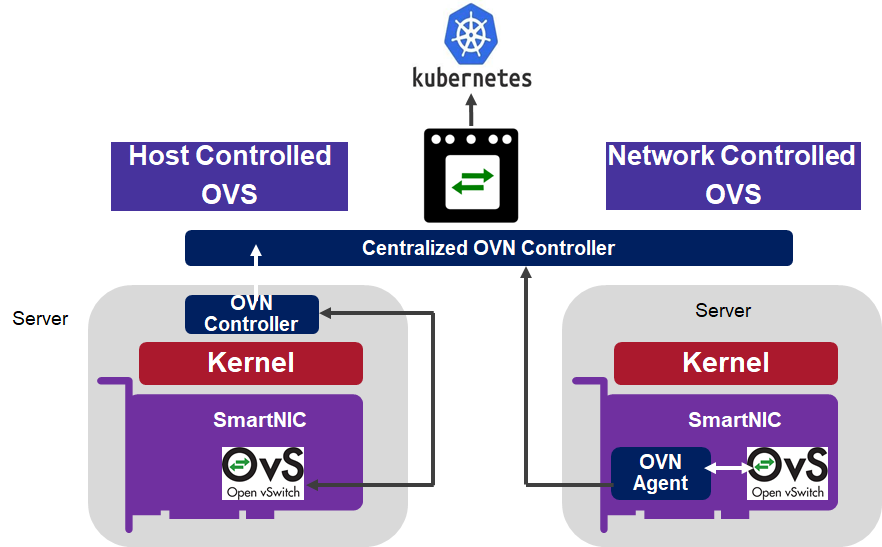| Table of Contents |
|---|
Blueprint overview/Introduction
Integrated Edge Cloud(IEC) is an Akraino approved blueprint family and part of Akraino Edge Stack, which intends to develop a fully integrated edge infrastructure solution, and the project is completely focused towards on Edge Computing. This open-source software stack provides critical infrastructure to enable high performance, reduce latency, improve availability, lower operational overhead, provide scalability, address security needs, and improve fault management. The IEC project will address multiple edge use cases and industry, not just the Telco Industry. IEC intends to develop solution and support of carrier, provider, and the IoT networks.
IEC Type 4 5 is focused on AR VR applications running on edgeSmartNIC, which could accelerate network performance and provide more management convenience.
In general, the architecture consists of three two layers: IaasIaaS (IEC), PaaS(Tars), SaaS(AR/VR Application).
Use Cases
In general, there are multiple use cases for AR VR itemized below. For Release 2, we focus on building the infrastructure and virtual classroom application (Highlighted in dark purple color).
Virtual Classroom is a basic app that allows you to live a virtual reality experience simulating a classroom with teachers and students.
...
UseCases
...
Value Proposition
...
Operation Guidance
...
Predict the next step for the operations(like assembling Lego blocks, cooking sandwiches, etc) and help people to achieve a goal.
...
Virtual Classroom
...
Simulating a virtual classroom, which improves online education experiences for the teachers and students.
...
Sports Live
...
Augment and simulate the sports live, which gives the audiences an amazing immersive watching experience.
...
Gaming
...
Augment and simulate the game scenario, let players enjoy an immersive game world.
, SmartNIC layer. But in R3, we have two simple layers: Host Layer, SmartNIC Layer.
Use Case
1. OVS-DPDK offload into SmartNic to accelerate the network performance and save computing resources which is important in the edge cloud environment
2. part of the UPF functions like load balance, forwarding, dpi, etc offloaded into SmartNIC to enhance the performance of UPF who will be deployed in carrier's edge cloud datacenters
Where on the Edge
Business Drivers: SmartNIC is located in edge cloud servers, which belongs to the EC infrastructure and VPC, 5G UPF can use SmartNIC to accelerate the performance.
Overall Architecture
SmartNIC Datacenter Services across all Clouds as the diagram shown below:
Platform Architecture
- OVS-DPDK offload into SmartNic
For R3 Release, we haven't used the Kubernetes component.
For the hardware components information:
Qty. | Item | Comments |
|---|---|---|
| 2 | x86 servers running CentOS 7.5 | Intel(R) Xeon(R) CPU E5-2630 v4 @ 2.20GHz / 40 cores / 2 numa / 64G memory |
| 1 | ConnectX-5 NIC (FW: 16.24.0328 and up) | - |
| 1 | BlueField 25GbE SmartNIC with Arm processor (FW: 18.24.1000 and up) | ARMv8 16 cores / single numa / 16G memory/ 25G bandwidth |
| 1 | 25GB/s SFP28 networking cable | - |
| 1 | QSA28 Adapter (100GB-to-25GB Adapter) | - |
| 1 | UART-to-USB cable | For SmartNIC USB console access |
| 1 | Mini USB Type B cable | For SmartNIC USB Console Access |
| 1 | bfb image to be loaded on the BlueField SmartNIC Arm. | Image contains:
|
Software Platform Architecture
| System | Software | DPDK | |
|---|---|---|---|
| Machine 1 | Centos 7.5 | OVS-DPDK 2.12 | version 19.11 |
| Machine 2 | Centos 7.5 | OVS-DPDK 2.12 | version 19.11 |
APIs
Not Applicable
Hardware and Software Management
The detailed hardware is itemized below
| Bare Metal Machine(Host Layer) | SmartNic Layer | System | Software | |
|---|---|---|---|---|
| Machine 1 | Intel(R) Xeon(R) CPU E5-2630 v4 @ 2.20GHz / 40 cores / 2 numa / 64G memory | ARMv8 16 cores / single numa / 16G memory / 25G bandwidth | Centos 7.5 | OVS-DPDK 2.12 |
| Machine 2 | Intel(R) Xeon(R) CPU E5-2630 v4 @ 2.20GHz / 40 cores / 2 numa / 64G memory | ARMv8 16 cores / single numa / 16G memory/ 25G bandwidth | Centos 7.5 | OVS-DPDK 2.12 |
Licensing
GNU/common license
After successfully deploy the virtual classroom application, the following virtual classroom is waiting for you. Enjoy!
Overall Architecture
The whole architecture, shown below, consists of two parts: the front end and the backend.
- For the front end, the minimal requirements are two clients, one for the teacher and the other one for the student. The client device could be a cellphone, tablets, wearable devices,personal computers, etc. The client collects information from the real world and transfers the data to the backend for calculation. Beyond data transfer and calculation, render is another function running on the front end client-side.
- For the backend, we deploy the backend in two virtual machines in the Cloud.
- To make the VR backend work well, we deploy IEC in the IaaS Layer, Tars framework in PaaS Layer, Virtual Classroom Backend in SaaS Layer.
- To make CI/CD available, we deploy Jenkins Master in one Virtual Machine. The Jenkins master issues command to triger the script run on the dedicated VM.
Tars is a high-performance microservice framework based on name service and Tars protocol, also integrated administration platform. For more information about Tars, refer to the following documents:
IEC (Integrated Edge Cloud) is a platform that will enable new functionalities and business models on the network edge. The benefits of running applications on the network edge are - Better latencies for end users - Less load on network since more data can be processed locally - Fully utilize the computation power of the edge devices. Here IEC Type2 is used as the main working base for IEC Type4 deployment orchestration. For more information about IEC, refer to the following documents:
IEC Release Type2 Documentation
Optimization
To address the requirements of time-critical Application, some optimizations are itemized below:
- High-Performance RPC: Tars Framework supports a high-performance RPC Protocol, called Tars Protocol. To improve the performance, the Tars protocol re-design a brand new RPC protocol and make the transfer between "request" and "Binary stream" more efficiently. In terms of the detail of Tars protocol, refer to the Tars.h file in the https://github.com/TarsCloud/Tars.
- Lightweight framework
- To make Tars can be well deployed on the edge computing platform, we make the framework pluggable. The customer plugin the pluggable components when we really need it. Unnecessary components can be avoided.
- Rewrite some functions(like scale-out, monitor and so on) to reduce CPU consumption.
- Orchestrate no-urgent functions(like monitor data calculation and so on) from edge to DC(or higher level edge). Reduce resource consumption.
- IEC Optimization: IEC uses Calico as the main container networking solution which uses a pure IP networking fabric to deliver high-performance Kubernetes networking, and its policy engine enforces developer intent for high-level network policy management. Together, Calico and Kubernetes provide a secure, cloud-native platform that can scale your infrastructure to support hundreds of thousands of users. Calico CNI also supports multi-cni plugin. In this way, users can customize their own edge systems.
Main Progresses for Release 2
Release 2 is the first release for IEC Type 4. So everything is new.
Build Of Materials (BOM) / Hardware requirements
For R2, we deploy IEC in Tencent Cloud for Release. The detailed hardware is itemized below:
...
CPU+Memory
...
Drive
...
Deployment
...
4Core * 16G
...
50G
...
Jenkins Master
...
4Core * 16G
...
50G
...







